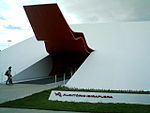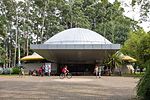Museum of Contemporary Art, University of São Paulo
1963 establishments in BrazilArt museums and galleries in BrazilArt museums established in 1963Brazilian arts stubsBrazilian building and structure stubs ... and 3 more
Museums in São PauloSouth American museum stubsUniversity of São Paulo

The Museum of Contemporary Art, University of São Paulo (Portuguese, Museu de Arte Contemporânea da Universidade de São Paulo) is a contemporary art museum located in the main campus of the University of São Paulo, in São Paulo, Brazil, and in Ibirapuera Park, in the same city. It is one of the largest art museums in the country.
Excerpt from the Wikipedia article Museum of Contemporary Art, University of São Paulo (License: CC BY-SA 3.0, Authors, Images).Museum of Contemporary Art, University of São Paulo
Avenida Pedro Álvares Cabral, São Paulo Moema
Geographical coordinates (GPS) Address Phone number Website External links Nearby Places Show on map
Geographical coordinates (GPS)
| Latitude | Longitude |
|---|---|
| N -23.588888888889 ° | E -46.651111111111 ° |
Address
Museu de Arte Contemporânea da Universidade de São Paulo (Museu de Arte Contemporânea)
Avenida Pedro Álvares Cabral 1301
04094-050 São Paulo, Moema
São Paulo, Brazil
Open on Google Maps










